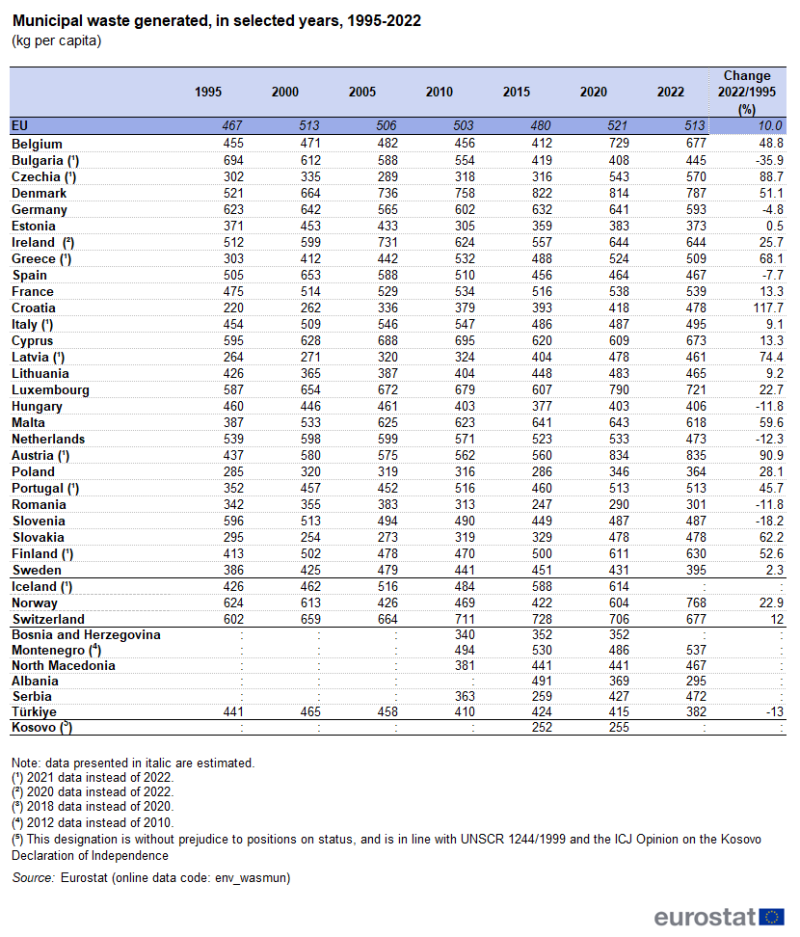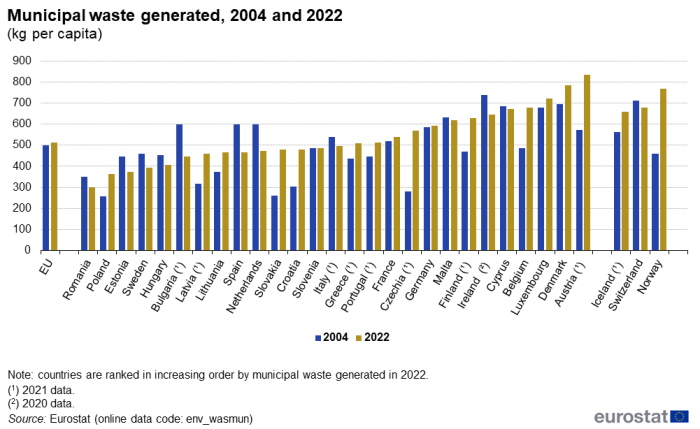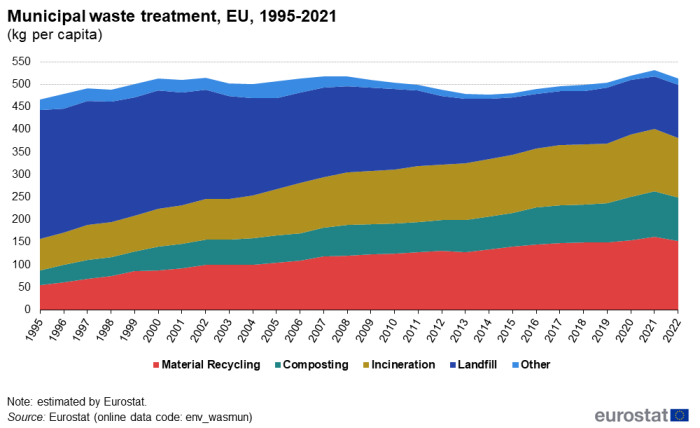Municipal waste statistics
Data extracted in February 2024.
Planned article update: February 2025.
Highlights
Municipal waste generated, 2004 and 2022
This article shows trends in municipal waste generation and treatment in the European Union (EU) from 1995 to 2022. There is a distinct trend towards less landfilling as countries move steadily towards alternative ways of treating waste.
Municipal waste accounts for only about 10 % of total waste generated when compared with the data reported according to the Waste Statistics Regulation (env_wasmun). However, it has a very high political profile because of its complex character, due to its composition, its distribution among many sources of waste and its link to consumption patterns.
Full article
Municipal waste generation
Figure 1 and Table 1 show municipal waste generation by country expressed in kilograms per capita. To illustrate trends, Table 1 shows waste for selected years, covering the period 1995 to 2022. For better readability, Figure 1 covers only the years 2004 and 2022. Both include the EU aggregates for comparison. In Figure 1, countries are ranked in increasing order by municipal waste generation in 2022.
For 2022, municipal waste generation totals vary considerably, ranging from 301 kg per capita in Romania to 835 kg per capita in Austria. The variations reflect differences in consumption patterns and economic wealth, but also depend on how municipal waste is collected and managed. There are differences between countries regarding the degree to which waste from commerce, trade and administration is collected and managed together with waste from households.
From 2004 on, methodologies were finalised in most countries, so the waste generation time series of 2004 and later is more accurate and stable than that of 1995 to 2003.

(kg per capita)
Source: Eurostat (env_wasmun)
Municipal waste treatment
In this section, differences in the management of municipal waste are shown and treatment strategies are identified based on reported amounts of municipal waste landfilled, incinerated, recycled and composted. EU Member States are asked to distinguish between incineration with and without energy recovery[1]. In this article only the total amount incinerated is analysed.
Table 2 shows the amount of municipal waste treated in the EU for the period 1995 to 2022 by treatment method, in million tonnes and in kg per capita. Figure 2 shows the amount of waste generated at EU level and the amount of waste by treatment category (landfill, incineration, material recycling, composting and other).

Source: Eurostat (env_wasmun)
The 'other treatment' category was calculated as the difference between the sum of the amounts treated and the amounts of waste generated. This difference arises in countries that have to estimate waste generation in areas not covered by a municipal waste collection scheme and thus report more waste generated than treated. In addition, the 'other treatment' category reflects the effects of import and export, weight losses, double-counting of secondary waste (e.g. landfilling and recycling of residues from incineration), differences due to time lags, temporary storage and, increasingly, the use of pre-treatment, such as mechanical biological treatment (MBT). This may even lead to a rise in 'other treatment' for a given year. At EU level, these effects contribute only marginally and tend to cancel each other out. However, at country level, the effects can be considerable.
Even though more waste is being generated in the EU, the total amount of municipal waste landfilled has diminished. In the reference period, the total municipal waste landfilled in the EU fell by 69 million tonnes, or 56 %, from 121 million tonnes (286 kg per capita) in 1995 to 53 million tonnes (118 kg per capita) in 2022. This corresponds to an average annual decline of 3.1 %. For the shorter period 2004-2022, landfilling fell by 3.2 % per year on average.
As a result, the landfilling rate (landfilled waste as share of generated waste) in the EU dropped from 61 % in 1995 to 23 % in 2022.
This reduction can partly be attributed to the implementation of European legislation, for instance Directive 62/1994 on packaging and packaging waste. By 2001, EU Member States had to recover a minimum of 50 % of all packaging put on the market. With the revised recovery target of 60 % to be achieved by 31 December 2008, there was a further rise in the amount of packaging waste collected separately. By 31 December 2025 65 % of the packaging waste has to be recycled.
Furthermore, Directive 31/1999 on landfill stipulated that EU Member States were obliged to reduce the amount of biodegradable municipal waste going to landfills to 75 % by 16 July 2006, to 50 % by 16 July 2009, to 35 % by 16 July 2016 and to 10 % until 2035. The reduction was calculated on the basis of the total amount of biodegradable municipal waste produced in 1995. The Directive has led to countries adopting different strategies to avoid sending the organic fraction of municipal waste to landfill, namely composting (including fermentation), incineration and pre-treatment, such as mechanical-biological treatment (including physical stabilisation).
As a result, the amount of waste recycled (material recycling and composting) rose from 37 million tonnes (87 kg per capita) in 1995 to 111 million tonnes (248 kg per capita) in 2022 at an average annual rate of 4.0 %. The share of municipal waste recycled overall rose from 19 % to 48 %.
Waste incineration has also increased steadily in the reference period, though not as much as recycling and composting. Since 1995, the amount of municipal waste incinerated in the EU has risen by 29 million tonnes or 98 % and accounted for 59 million tonnes in 2022. Municipal waste incinerated has thus risen from 70 kg per capita to 133 kg per capita.
Mechanical biological treatment (MBT) and sorting of waste are not reported as separate categories of municipal waste treatment, as they are types of pre-treatment that require an additional final treatment. In practice, the amounts delivered to mechanical biological treatment or sorting should be reported on the basis of the subsequent final treatment steps. However, the way these amounts are allocated to the four treatment categories (incineration, landfilling, recycling and composting) varies significantly and some countries report only on the first (pre-)treatment step.
As a consequence, reporting on the current set of variables often requires additional information to relate the amounts of municipal waste landfilled, incinerated, recycled and composted to the amounts generated at country level.
Source data for tables and graphs
Data sources
The data cover the period from 1995 to 2022 for the 27 EU Member States (Croatia only has complete sets since 2006). For the candidate countries,coverage is as follows: Bosnia and Herzegovina (since 2008), North Macedonia (since 2008), Albania (since 2013), Serbia (since 2011) and Türkiye. For the EFTA countries, Iceland, Norway and Switzerland and the potential EU candidate countries Kosovo[2] and Albania (since 2013), data are given to the extent possible.
Definitions
The municipal waste classification is based on the Directive 851/2018 amending the Waste Framework Directive (Directive 2008/98/EC) and on the definitions for the section on waste in the OECD/Eurostat Joint Questionnaire. Further information is available in the
- ESMS metadata sheet on municipal waste (ESMS metadata file — env_wasmun_esms)
MW generated / MW collected: The data refer to the amount of municipal waste generated. In countries with complete (national) coverage of their municipal waste collection scheme, the total of municipal waste generated is equal to the total of municipal waste collected. Some countries do not cover their whole territory with a collection scheme. These countries have added an estimate of the waste generated in areas not covered. For some countries data prior to 2008 refer to municipal waste collected, as it was not possible to make an estimate for the population not covered.
Data for France include the overseas departments (département d'outre-mer or DOM) Martinique, Guadeloupe, Réunion and French Guiana.
Data for Cyprus refer only to the area under the effective control of the Government of the Republic of Cyprus.
Data for Liechtenstein are included in Switzerland.
Context
Eurostat has collected and published data on municipal waste since 1995. Eurostat has conducted surveys on European waste data using the OECD/Eurostat-Joint Questionnaire as the main source. After the introduction of the Regulation (EC) No 2150/2002 of 25 November 2002 on waste statistics the data collection on municipal waste based on the joint Questionnaire was continued to maintain the time series and to offer consistent data in an international context outside the EU (OECD, UN).
Direct access to
- Energy, transport and environment statistics - 2020 Edition
- Generation and treatment of municipal waste - Statistics in focus 31/2011
- Waste statistics (ESMS metadata file — env_wasmun_esms)
- Regulation (EC) No 2150/2002 of 25 November 2002 on waste statistics
- Directive (EU) 2018/851 of 30 May 2018 amending Directive 2008/98/EC on waste
- Waste Framework Directive (Directive 2008/98/EC)
- Directive 1999/31/EC of 26 April 1999 on the landfill of waste
- Summaries of EU legislation: Landfill of waste
- Directive 94/62/EC of 20 December 1994 on packaging and packaging waste
- Summaries of EU legislation: Packaging and packaging waste
Notes
- ↑ Annex II of the Waste Framework Directive includes an energy efficiency criterion that helps to classify incineration facilities and to improve data comparability. The criterion came into force on 12 December 2010.
- ↑ This designation is without prejudice to positions on status, and is in line with UNSCR 1244/1999 and the ICJ Opinion on the Kosovo Declaration of Independence.

